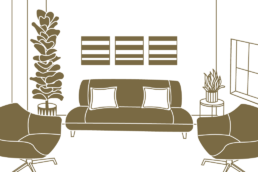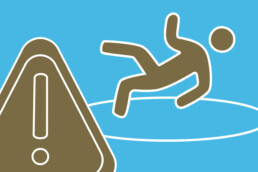Enhancing your brand identity: transforming your office space for success
Your office is more than just a place where work happens—it’s a reflection of your brand’s identity. Every aspect of your workspace, from the decor to the atmosphere, plays a crucial role in shaping how your brand is perceived. In this article, we’ll explore the importance of aligning your office space with your brand’s personality and voice, and we’ll share an inspiring success story of how a simple office reimagining led to a significant transformation for one of our clients.

Assess your office decor
Before diving into our client’s story, let’s start with some essential questions to assess your office decor:
- Does it look like you just moved in, or is it thoughtfully curated for your target clientele?
- Does the tone of your office support and reinforce your brand personality and voice?
- Is your office connected with your demographic or industry, both in aesthetics and functionality?
- Does it exhibit your competence in your field and showcase your brand’s values? If so, how?
If you feel that your office decor isn’t fully aligned with your brand, don’t worry—we’ve got you covered. Keep reading to find out how a simple reimagining can elevate your brand’s image and create a lasting impact on your customers. (If you’re still figuring out your voice, you can read about the elements of strong brand foundation here.)
The power of brand experience
At Sands Costner, we firmly believe that every interaction with your brand matters. Your office space is a vital touchpoint where customers experience your brand firsthand. The feelings and emotions evoked by your office decor directly contribute to your customers’ overall satisfaction with your brand.
Now, let’s delve into our client’s success story to demonstrate the true power of brand experience through office transformation.
A client's journey: from ordinary to extraordinary
Our client, a warm and caring professional company, had just completed the exciting process of rebranding with our team. Through extensive research and personal interviews with the company, we gained valuable insights into their brand’s core values, which were centered around care and professional communication. With their new identity fully embracing these values, we recognized a unique opportunity to enhance their brand experience further by transforming their office spaces.
Like many fast-paced, customer-centric businesses, office decor was often on the backburner as they prioritized delivering top-notch service to their clients. However, we understood that aligning their physical spaces with their new brand identity was crucial to reinforce their voice of warmth and genuine concern for their clients’ well-being. As we prepared to unveil their new logo on the walls, we also embarked on updating the office spaces to create a seamless brand experience.
The vision for transformation
We realized a simple office reimagining could make a world of difference in aligning their brand with their physical space. Our goal was to create an environment that not only felt professional but one that also exuded warmth and care.
- We introduced plants to add life and growth while aligning with their branding colors.
- Local art pieces were commissioned to showcase brand colors and foster a connection with the community.
- Soft furnishings, such as throw pillows and decor in brand colors, elevated the existing furniture.
- We de-emphasized highly-chromed furniture by layering in warm metal accents to enhance the inviting atmosphere.
- Increasing Accessibility: To make the office more inclusive, we reconfigured the layout to ensure it was accessible to all clients.
The results
The impact of these simple yet purposeful changes was remarkable. The office’s transformation better aligned with our client’s brand personality and voice. Employees felt more motivated and connected to the brand, and clients appreciated the warm, caring atmosphere.



Transform your brand experience
At Sands Costner, we are passionate about designing strategies that elevate your brand experience. Your office space should tell a story that resonates with your customers and employees alike. By aligning your office decor with your brand, you create a seamless and memorable brand experience.
Final thoughts
Your office space is a canvas on which your brand’s personality can truly shine. Whether you own the space or face certain limitations, creative solutions can infuse your environment with your brand’s essence. By asking yourself the right questions and seeking professional guidance, you can create an office space that fosters trust, loyalty, and lasting relationships with your customers.
If you’re ready to take your brand experience to the next level, we’re here to help. Whether you need assistance with firming up your marketing strategy, brand language, or visual foundations, or simply need guidance on transforming your office decor, our team of designers, strategists, marketers, and artists is at your service. Reach out to us at grow@sandscostner.com and let’s bring your brand’s vision to life.
About us
Sands Costner is a marketing and advertising agency that specializes in preparing small businesses for—and guiding them through—stages of major growth. We exist to help companies meet their objectives year after year through strategic planning and effective branding.
Quality Leasing Co., Inc. Rebrands as Quality Equipment Finance
Quality Leasing Co. is now Quality Equipment Finance, thanks to a sustained period of record growth and a campaign to realign and reaffirm the company’s brand and positioning.
2022 saw growth in staff; restructured operations and management in its Carmel, Indiana headquarters and several satellite offices; and a number of new technologies. Alongside a significant 63% growth in year-over-year funding volume reported through 3Q22, the company added seasoned executive leadership from the industry and additional sales consultants who embody the company’s commitment to personal customer service and excellence—a value customers and partners have grown to expect and trust.
In the midst of this growth, Quality has been developing new technology, refining its underwriting process and making its financing programs ever more competitive. It celebrated its 65th anniversary earlier this year by rolling out EZ-Q, a new application-only program for transactions up to $150,000. All these investments fuel Quality’s momentum going into 2023.
“We are constantly fine-tuning our newest tech platforms to make deal submissions easier, credit decisions faster and funding processes smoother for everyone involved,” said G. Paul Fogle, CLFP and managing director at Quality. “We wanted our brand to better reflect our position in the market.”

The company itself uses equipment finance agreements, or EFAs, as its primary financing method, a major factor in the renaming. Quality partnered with the growth-focused marketing agency Sands Costner to work on the rebranding. Quality now boasts a new website, new logo, and a focused mission: to invest in the success of small businesses with fast and fair commercial equipment financing.
“Sands Costner helped us clarify our position and reaffirm our commitment to our customers,” says Fogle. “We’ve experienced significant growth for some time, and our programs and offerings have expanded and evolved to be more robust than ever. We haven’t forgotten that this is all about the people we empower to do big things all over the country. Our dependability and human touch are still our hallmarks.”
About Quality Equipment Finance
Quality Equipment Finance is a broker’s most dependable funding partner, since 1957. Our people-centered approach, streamlined tech, and straightforward underwriting create easy wins for brokers and their borrowers. We understand the challenges that small businesses face every day. It’s our goal to provide commercial financing that supports their success.
About Sands Costner
Sands Costner is a marketing and advertising agency that specializes in preparing small businesses for—and guiding them through—stages of major growth. For more than forty years it has helped companies meet growth objectives through strategic planning and effective branding and advertising.
Rebranding: 4 common pitfalls, plus insider tips for an effective rebrand
So you’ve determined that you need to rebrand your organization, or at least to refresh your visual identity. You may have already decided on a scope of work, or chosen a branding agency to work with. Here then is some advice about the rebranding process: both best practices and mistakes to avoid in pursuit of a successful rebranding.
Since you’re reading this, you likely already know what rebranding is (if not, we love the definition provided by the good folks at Hubspot). So here then are the most common pitfalls when rebranding—and how to avoid them—from your favorite Tacoma marketing agency.
Mistake #1 - Tackling your rebrand in-house
Let’s get a big concession out of the way: yes, it’s inarguably self-serving of us to claim that you need to work with an agency when rebranding. Still … we do make that claim, and we’re not wrong.
There are two reasons we’ve seen business owners choose to undertake their rebrand entirely in-house: the most prevalent is to save money. The other (less common) reason is to give work to a friend or relative who is a designer.
Now, IF your friend or relative is a professional graphic designer with experience in corporate brands, then great! You’ve got one piece of your rebranding campaign taken care of. But are they also skilled at copywriting for brand voice? At consumer research? At web design? Or brand awareness and advertising? Social media and content marketing? At tying your rebrand to your growth strategy? If so, then look no further!
Most of the time, rebranding involves more than a new logo and color palette. Yet many business owners seeking out help with their rebrand equate it with just that.
Rebranding certainly can save money in the long run. It’s a mistake to cut costs, however, by deciding that all you need for your rebrand is a fresh logo. Those who understand the complexity of rebranding tend to seek out agency help from the get-go. Think of rebranding as a recalibration of your entire business. Like a car, it needs periodic realignment. A paint job alone doesn’t do the trick.
THE FIX: Hire an agency that’s experienced in rebranding and staffed by people you want to work with. Use your in-house marketing team to help communicate your corporate identity to the agency, and to help execute strategies you and your agency devise.
Mistake #2 - Lifeless values, inert purpose, and mindless mission
We’ll be blunt: more often than not, corporate values suck. If a company lists their values at all, they tend to be vague and overreaching. More often than not, employees aren’t aware of them, or if they are, then they’re not sure how to manifest them in their work.
Similarly, a company’s statement of purpose is often bland and uninspiring. This is true even when a founder is charismatic and/or embodies excellent leadership qualities. Why? Because crafting an inspiring statement of purpose is a different skill from leading a company. It’s the skill of aligning the specific motivations shared by all your stakeholders into a single catalyzing statement, without making it feel overstuffed and flabby.
Then there are mission statements, the institutional fiber of the business world: they’re healthy, natural, and keep things moving in one direction. Many mission statements are crafted as window dressing, or as placeholders, a necessary checklist item for business owners. Most can’t pass the replacement test, however; statements so generic that one could swap item x for item y and not change anything. They completely miss the opportunity to create structure or the obligation implied by “mission.” Often lost in discussion of mission statements is their link to the notion of assignment. Missions are operations dictated by a higher power and evoke a sense of calling and duty. They are an authentic vocation born of specific people’s values and personality.
A successful rebrand depends on a healthy core brand foundation. If you undertake a rebrand without examining these elements, you’re likely just putting lipstick on a pig.
THE FIX: When hiring an agency, ask how they define values, purpose, and mission. Ask what role they feel this foundation plays in your overall growth strategy, and ask about the process they use to develop and tighten this core brand foundation. And make sure they have a sense of how they’ll get stakeholder buy-in.
Mistake #3 - Rebranding without growth planning
Your rebranding strategy can be rock-solid, but if it isn’t aligned with an equally solid growth strategy, then it’s hard to see it actually helping your business in the long term.
Rebranding isn’t just a single marketing campaign; it’s about realigning the corporate identity you project in order to optimize and sustain your market share year after year. If your company doesn’t have a plan in place addressing how it will grow, then the extra market share will prove temporary, and could actually damage an unprepared business (for example, by not fulfilling promises; providing a lackluster customer service experience; or developing an inhospitable work environment, among other dangers.)
You should already be thinking about growth strategies along with any rebrand, and have a clear idea about the most likely strategy for long-term growth.
We can’t emphasize enough the fact that rebranding isn’t just about a single visual design element or new tagline; it’s a structural realignment of your entire corporate identity. Your rebrand won’t just spur growth; it will shape and contain it.
THE FIX: Even before you’ve signed a contract, share with your agency any growth plans you have, whether formalized or not. Not sure what to include or what to ask? Download our checklist of relevant growth planning questions here!
Mistake #4 - Miscommunication
Seems like a no-brainer, but communication is key to any successful rebrand. That means communication not just with your agency, but also within your own team. Here are some problems that can manifest from poor communication:
- Unvoiced assumptions and expectations
- Don’t assume the agency will be handling a particular task, or expect your rebrand to yield a particular result, without letting your own team and your agency know
- You may feel attached to a color, look, name, or typeface. Let everyone involved know your feelings. Take time to thoughtfully explain or justify any strong feelings you may have … or else be willing to be flexible.
- Operating on old information, or going by gut
- Rebranding involves knowing your customer, and that involves homework. If you haven’t done yours in a while (say, since your founding?) be prepared to roll up your sleeves.
- When you’re too close to a brand, it can be easy to miss the bigger picture because of your investment in it, or to make brand decisions based on personal pain points.
- Bottlenecks and cost overruns
- Bottlenecks happen frequently as a result of new processes or new people. Bringing in an agency to help with your rebrand involves both. Communicate roles and responsibilities, and establish reasonable workflows and timetables.
- Cost overruns often happen when the scope of a campaign changes mid-project, which can mean adding on sub-projects. Or it happens when you and your agency aren’t dialed in together. This means additional iterations and rounds of approvals.
THE FIX: For all of these issues, clear and consistent communication is the key to a fruitful partnership and successful rebrand. It’s been said before: the worst mistake you can make with regards to communication is to assume it’s happened.
It helps to think of your rebrand as a relay race and not a tennis match: for every heat, you have to get up to speed in order to pass the baton to your counterpart and maintain an overall cadence. You are on the same team, and not just lobbing a ball back and forth.
Rebranding with a Tacoma marketing agency
Some good news at the end of this list of potential pitfalls: we’ve taken pains to include only items that are well within your control.
If you’re interested in what a marketing agency can do for your rebrand—whether you’re just looking for a logo refresh or a full and proper realignment of your brand foundation, take a glance at our work and, if it resonates, give us a call. Or email us at grow@sandscostner.com.
About us
Sands Costner is a marketing and advertising agency that specializes in preparing small businesses for—and guiding them through—stages of major growth. We exist to help companies meet their objectives year after year through strategic planning and effective branding.
How to use your marketing agency to create a winning growth strategy
Marketing planning is often conflated with growth planning, though they are two different processes aimed at solving different problems. The former focuses entirely on traditional marketing activities: that is, how you intend to reach audiences and promote your product or service. The latter focuses on expansion—of audiences, products, or both—and assumes a more whole-business approach. Yet there are virtually no aspects of a business in the 21st century that marketing doesn’t touch. Your brand is a function of your core identity; your products and services are a response to an understanding of your audience’s needs and values. Soup to nuts, business growth planning IS marketing, and the best marketing agencies understand this and can help you develop and execute a winning growth strategy.
Why plan for growth?
We’ve written elsewhere about the stages of organizational growth, and how a business can remain in survival mode indefinitely. Small business owners who are able to develop a sustainable cash flow find it comfortable or even advantageous to remain in that stage. And more power to them, especially if they can remain in that sweet balance of size profitability.
But there are plenty of reasons that business owners seek to undertake growth planning. Note that growing and planning for growth are two different things. You can’t control all aspects of growth. And growth seldom just happens. You have to plan for it.
So why do some business owners want to grow?
- Treading water can be tiring, boring, or both. It can also be unsustainable even with positive cash flow since business owners are human and their energy is a finite resource
- The business has hit a growth plateau without achieving sustainable positive cash flow
Growth is part of the mission statement - The company is bringing new products or services to market, per the initial business plan, or is creating or buying new organizational divisions
- The founder wants or needs to disengage from day-to-day operations, and needs to establish a brand identity and/or sales strategy that is independent of their personality and relationships
There are other reasons, but these are a few of the biggies. Each situation requires careful planning.
Of course, growth happens with or without planning. Sometimes business owners have to hustle to control costs or manage growth after the fact. Better late than never: growth without adequate planning can quickly sink a business.
What does business growth planning consist of?
Growth planning can be a messy process since it involves thoughtful analysis of your operations, your brand identity, your vision and goals, and the ever-shifting needs and values of your customers. There are a lot of moving parts, and making sense of them requires experience, knowledge, and time.
Discovery
The beginning stage of any business growth planning is essentially a description of your business. What is your value proposition? What are your mission, vision, purpose, and values? Who is on your team?
Research and analysis
Who are your customers? Who are your competitors? Got time for a SWOT analysis? What are your finances like? The better you understand your business—not how it was originally conceived, but how it functions now—the stronger your growth strategy will be.
Survey of products and services
What are your products and services? What problems do they solve? Whose problems do they solve? How well do they solve them? Are there other people whose problems would be solved by your product or service? Can people get your product or service easily enough?
What is a business growth strategy?
Your growth strategy will be the outcome of your planning. Good news: as messy as the planning stage can be, your ultimate strategy will likely take on just one or two of several possible flavors. There are essentially four main business growth strategies, and they are functions of markets and products (and from here on we’ll just say “product” to refer to products and/or services).
Business growth planning also includes taking a look at capital and staffing needs, but these are factored into your final growth plan and aren’t part of the basic growth strategy.
Market penetration: existing product, existing market
With market penetration, the strategy is to increase your market share within an existing market. You’re not offering new products. You can do this with tactics like direct marketing, social media marketing, or lowering prices.
Market development: existing product, new market
In market development, you’re bringing your product to a new, previous untapped (or even unidentified) audience. This can mean a demographic change (new regions or new customer types), or it can mean a new distribution channel, such as an online store or mobile van.
Product development: new product, existing market
Sometimes business growth planning reveals the need for new and/or improved products. Either your product isn’t meeting the needs of your customers as well as it could be, or your customers’ needs and values have evolved to necessitate the development of new products. Your market remains the same; you’ll just need a go-to-market strategy.
Diversification: new product, new market
This is the trickiest strategy of the bunch, and the most prone to failure. If your planning has uncovered both a need for new products and a need to reach new markets, then a lot of careful calibration is required. Even with planning, diversification efforts are risky. Potential rewards are high, however, if you manage to create a product that people didn’t know they needed until it was presented to them.
A good growth strategy is aligned with both your core identity—your values, purpose, and vision—and the needs and values of your customers. This strategic alignment will ensure the effectiveness of any campaigns or initiatives you undertake in the name of your growth strategy.
How to be sure: partnering with an agency
The problem is, business owners who are looking for a growth strategy are either too busy to do the planning that ensures that the strategy is sound, or they undertake the planning without the benefit of experience or hindsight.
This is where it helps to partner with an agency that does growth planning.
But what do you look for? What is that agency called? If you google “growth planning agency” you probably won’t find much. Especially not if you’re looking for someone in your area, whom you can meet face-to-face.
That’s where your local marketing agency can help.
As we’ve established, growth planning IS marketing. And the better marketing agencies understand this and can offer a range of services beyond the traditional graphic design, advertising, and branding.
Here are some questions you can ask your local marketing agency to suss out if they’ll be able to help you:
- What is your experience with growth planning?
- What are your core strengths as an agency?
- Can you advise on different stages of business growth?
- What is your approach to crafting a go-to-market strategy?
- Do you look at finances and staffing when writing strategic marketing plans?
If you have used a marketing agency to write a business growth plan, we’d love to hear about your experience! Send us a note at grow@sandscostner.com.
If you’re a business owner looking for a marketing agency to help you with business growth planning, we’d be happy to chat with you about your needs. And if you’re in Tacoma or the South Puget Sound region, we’d love to meet up with you in person!
About us
Sands Costner is a marketing and advertising agency that specializes in preparing small businesses for—and guiding them through—stages of major growth. We exist to help companies meet their objectives year after year through strategic planning and effective branding.



